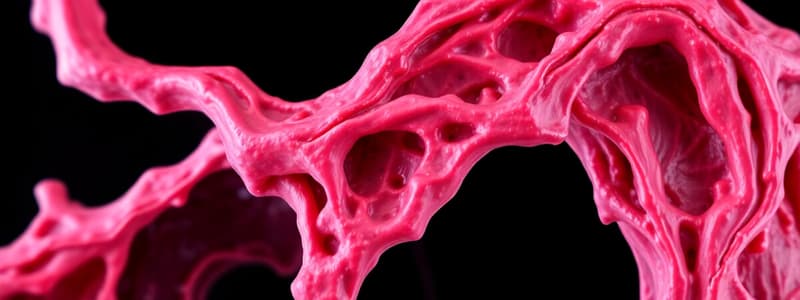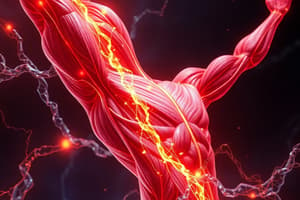Podcast
Questions and Answers
What is the primary function of skeletal muscle tissue?
What is the primary function of skeletal muscle tissue?
- To contract and move bones. (correct)
- To regulate passage of substances through the body.
- To generate heat without movement.
- To control heartbeats.
Which type of muscular tissue is responsible for moving blood through the heart?
Which type of muscular tissue is responsible for moving blood through the heart?
- Myofibril tissue
- Smooth muscle tissue
- Skeletal muscle tissue
- Cardiac muscle tissue (correct)
What does the term 'myology' refer to?
What does the term 'myology' refer to?
- The study of muscular tissue (correct)
- The study of motion in animals
- The study of muscle contraction
- The classification of muscle types
Which property of muscular tissue allows it to be stretched without tearing?
Which property of muscular tissue allows it to be stretched without tearing?
What is the role of fascia surrounding muscles?
What is the role of fascia surrounding muscles?
Which layer of connective tissue wraps the entire muscle?
Which layer of connective tissue wraps the entire muscle?
What are muscle fibers also known as?
What are muscle fibers also known as?
What type of connective tissue surrounds bundles of muscle fibers?
What type of connective tissue surrounds bundles of muscle fibers?
What is the primary function of the endomysium in skeletal muscle?
What is the primary function of the endomysium in skeletal muscle?
What is the structure that connects muscles to bones called?
What is the structure that connects muscles to bones called?
Which type of neurons regulate voluntary muscle contraction?
Which type of neurons regulate voluntary muscle contraction?
Which component of muscle fibers is responsible for electrical signal propagation?
Which component of muscle fibers is responsible for electrical signal propagation?
What is the term for the increase in muscle fiber volume due to new protein synthesis?
What is the term for the increase in muscle fiber volume due to new protein synthesis?
What are myofibrils primarily composed of?
What are myofibrils primarily composed of?
Which zone of the sarcomere contains only thick filaments?
Which zone of the sarcomere contains only thick filaments?
What connects the two bellies of the occipitofrontalis muscle?
What connects the two bellies of the occipitofrontalis muscle?
What is the specialized smooth endoplasmic reticulum in muscle cells called?
What is the specialized smooth endoplasmic reticulum in muscle cells called?
What role does myoglobin play in muscle cells?
What role does myoglobin play in muscle cells?
Flashcards are hidden until you start studying
Study Notes
Introduction to Muscular Tissue
- There are three types of muscle tissue: skeletal, cardiac, and smooth.
- Each muscle type has distinct functions:
- Skeletal muscle contracts to move bones and stabilize body positions.
- Cardiac muscle contracts to move blood through the heart.
- Smooth muscle contracts to regulate the passage of substances through the body, such as in the gastrointestinal tract and blood vessels.
- All muscle tissue generates heat during contraction.
- The scientific study of muscle tissue is called myology.
- Muscular tissue possesses four specialized properties:
- Excitability: This type of tissue can produce electrical signals called muscle action potentials. Nerve tissue is also excitable.
- Contractility: Muscle action potentials stimulate contraction, which generates tension on bones, leading to movement.
- Extensibility: Muscular tissue can be stretched without tearing, such as smooth muscle around the stomach.
- Elasticity: Muscular tissue can return to its resting length after being stretched.
The Structure of Skeletal Muscle
- Skeletal muscle cells are known as muscle fibers, which are elongated cells also called myocytes.
- Muscle fibers contain bundled protein filaments called myofibrils.
- A muscle is an organ composed of muscle fibers, connective tissue, nerves, and a blood supply.
- Muscles are surrounded by connective tissue layers called fascia, which group muscles together with similar functions and provides passage for nerves and vasculature.
The Fascia
- The fascia is composed of three layers:
- Epimysium: The most superficial layer, composed of dense irregular connective tissue that wraps muscles.
- Perimysium: The intermediate layer, composed of dense irregular connective tissue that wraps fascicles (bundles of muscle fibers).
- Endomysium: The deepest layer, composed primarily of reticular fibers that wrap individual muscle fibers.
Tendons
- The fascia forms tendons, which connect muscles to bones as thick rope-like structures.
- Aponeuroses are a special type of tendon that forms broad sheets, such as the epicranial aponeurosis connecting the two bellies of the occipitofrontalis muscle.
- Skeletal muscles require a significant amount of oxygen for aerobic cellular respiration, and therefore have an extensive blood supply.
- Skeletal muscles are extensively innervated by somatic motor neurons which regulate voluntary muscle contractions.
- Each muscle fiber typically receives one branch of an axon from a somatic motor neuron.
Skeletal Muscle Fiber Structure
- Individuals are born with all the muscle fibers they will ever have.
- Muscle fibers start as myoblasts in the womb.
- Myoblasts fuse as they mature to form large, multinucleate cells.
- The plasma membrane of a myocyte is called the sarcolemma, along which electrical signals run.
- The sarcolemma folds inward, or invaginates, to form T-tubules.
- The cytoplasm of a myocyte is called the sarcoplasm, which is densely packed with myofibrils and rich in glycogen, a carbohydrate energy store.
- The sarcoplasm also contains myoglobin, a protein that binds oxygen at an iron-containing heme group, allowing for internal oxygen supply in myocytes.
Myofibrils
- Myofibrils are long threads of contractile protein filaments, approximately 2 nm in diameter.
- The regular pattern of overlapping filaments gives skeletal and cardiac muscle a striated appearance.
Sarcoplasmic Reticulum
- The sarcoplasmic reticulum (SR) is the specialized smooth endoplasmic reticulum found in muscle cells.
- The SR is extensively folded around each myofibril, with membrane folds called cisternae.
- Terminal cisternae, specifically, release calcium ions (Ca2+) to each T-tubule.
- Where two terminal cisternae meet a T-tubule, a triad is formed.
- Muscle fibers do not divide, but can increase in size, or hypertrophy, through the addition of new proteins and cellular components.
Muscle Hypertrophy
- Hypertrophy is an increase in sarcoplasmic volume, where each muscle fiber increases its cellular contents, particularly myofibrils, mitochondria, SR, and other components.
- Hypertrophy is a response to:
- Increased mechanical stress (e.g., weight-bearing exercise)
- Hormones (e.g., anabolic steroids)
- Disease (e.g., increased demand on a diseased heart)
Sarcomere Structure
- Myofibrils are bundles of thread-like structures called myofilaments.
- Each myofilament is made of contractile units called sarcomeres, which are joined end-to-end.
- Each sarcomere consists of overlapping thick and thin filaments:
- Thick filaments extend from the midline (M-line) of the sarcomere and are made of myosin.
- Thin filaments extend from the ends (Z-discs) of the sarcomere and are made of actin.
Sarcomere Zones and Bands
- The sarcomere is divided into zones and bands:
- A band: The region where thick and thin filaments overlap and everything in between.
- H zone: The region between zones of overlap around the M-line, containing only thick filaments.
- I band: The region between zones of overlap around the Z-discs, containing only thin filaments.
Studying That Suits You
Use AI to generate personalized quizzes and flashcards to suit your learning preferences.




